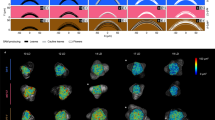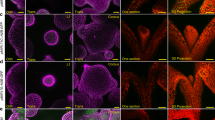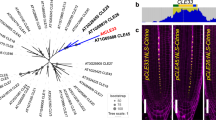Abstract
Leaves of flowering plants are determinate organs produced by pluripotent structures termed shoot apical meristems. Once specified, leaves differentiate an adaxial (upper) side specialized for light capture, and an abaxial (lower) side specialized for gas exchange. A functional relationship between meristem activity and the differentiation of adaxial leaf fate has been recognized for over fifty years, but the molecular basis of this interaction is unclear. In Arabidopsis thaliana, activity of the class I KNOX (KNOTTED1-like homeobox) genes SHOOTMERISTEMLESS (STM) and BREVIPEDICELLUS (BP) is required for meristem function but excluded from leaves1,2,3, whereas members of the HD-Zip III (class III homeodomain leucine zipper) protein family function to promote both meristem activity and adaxial leaf fate4,5,6. Here we show that the zinc-finger protein SERRATE acts in a microRNA (miRNA) gene-silencing pathway to regulate expression of the HD-Zip III gene PHABULOSA (PHB) while also limiting the competence of shoot tissue to respond to KNOX expression. Thus, SERRATE acts to coordinately regulate meristem activity and leaf axial patterning.
This is a preview of subscription content, access via your institution
Access options
Subscribe to this journal
Receive 51 print issues and online access
$199.00 per year
only $3.90 per issue
Buy this article
- Purchase on SpringerLink
- Instant access to full article PDF
Prices may be subject to local taxes which are calculated during checkout




Similar content being viewed by others
References
Long, J. A., Moan, E. I., Medford, J. I. & Barton, M. K. A member of the KNOTTED class of homeodomain proteins encoded by the STM gene of Arabidopsis. Nature 379, 66–69 (1996)
Lincoln, C., Long, J., Yamaguchi, J., Serikawa, K. & Hake, S. A knotted1-like homeobox gene in Arabidopsis is expressed in the vegetative meristem and dramatically alters leaf morphology when overexpressed in transgenic plants. Plant Cell 6, 1859–1876 (1994)
Byrne, M. E., Simorowski, J. & Martienssen, R. A. ASYMMETRIC LEAVES1 reveals knox gene redundancy in Arabidopsis. Development 129, 1957–1965 (2002)
McConnell, J. R. et al. Role of PHABULOSA and PHAVOLUTA in determining radial patterning in shoots. Nature 411, 709–713 (2001)
Emery, J. F. et al. Radial patterning of Arabidopsis shoots by class III HD-ZIP and KANADI genes. Curr. Biol. 13, 1768–1774 (2003)
Juarez, M. T., Kui, J. S., Thomas, J., Heller, B. A. & Timmermans, M. C. microRNA-mediated repression of rolled leaf1 specifies maize leaf polarity. Nature 428, 84–88 (2004)
Sussex, I. M. Morphogenesis in Solanum tuberosum L.: Experimental investigation of leaf dorsiventrality and orientation in the juvenile shoot. Phytomorphology 5, 286–300 (1955)
Chuck, G., Lincoln, C. & Hake, S. KNAT1 induces lobed leaves with ectopic meristems when overexpressed in Arabidopsis. Plant Cell 8, 1277–1289 (1996)
Gallois, J. L., Woodward, C., Reddy, G. V. & Sablowski, R. Combined SHOOT MERISTEMLESS and WUSCHEL trigger ectopic organogenesis in Arabidopsis. Development 129, 3207–3217 (2002)
McConnell, J. R. & Barton, M. K. Leaf polarity and meristem formation in Arabidopsis. Development 125, 2935–2942 (1998)
Bao, N., Lye, K. W. & Barton, M. K. MicroRNA binding sites in Arabidopsis class III HD-ZIP mRNAs are required for methylation of the template chromosome. Dev. Cell 7, 653–662 (2004)
Prigge, M. J. & Wagner, D. R. The Arabidopsis SERRATE gene encodes a zinc-finger protein required for normal shoot development. Plant Cell 13, 1263–1279 (2001)
Ori, N., Eshed, Y., Chuck, G., Bowman, J. L. & Hake, S. Mechanisms that control knox gene expression in the Arabidopsis shoot. Development 127, 5523–5532 (2000)
Englbrecht, C. C., Schoof, H. & Bohm, S. Conservation, diversification and expansion of C2H2 zinc finger proteins in the Arabidopsis thaliana genome. BMC Genomics 5, 39 (2004)
Golling, G. et al. Insertional mutagenesis in zebrafish rapidly identifies genes essential for early vertebrate development. Nature Genet. 31, 135–140 (2002)
Mallory, A. C. et al. MicroRNA control of PHABULOSA in leaf development: importance of pairing to the microRNA 5′ region. EMBO J. 23, 3356–3364 (2004)
Green, K. A., Prigge, M. J., Katzman, R. B. & Clark, S. E. CORONA, a member of the class III homeodomain leucine zipper gene family in Arabidopsis, regulates stem cell specification and organogenesis. Plant Cell 17, 691–704 (2005)
Smith, H. M. & Hake, S. The interaction of two homeobox genes, BREVIPEDICELLUS and PENNYWISE, regulates internode patterning in the Arabidopsis inflorescence. Plant Cell 15, 1717–1727 (2003)
Hay, A. et al. The gibberellin pathway mediates KNOTTED1-type homeobox function in plants with different body plans. Curr. Biol. 12, 1557–1565 (2002)
Alonso, J. M. et al. Genome-wide insertional mutagenesis of Arabidopsis thaliana. Science 301, 653–657 (2003)
Bowman, J. L., Smyth, D. R. & Meyerowitz, E. M. Genetic interactions among floral homeotic genes of Arabidopsis. Development 112, 1–20 (1991)
Bougourd, S., Marrison, J. & Haseloff, J. Technical advance: an aniline blue staining procedure for confocal microscopy and 3D imaging of normal and perturbed cellular phenotypes in mature Arabidopsis embryos. Plant J. 24, 543–550 (2000)
Acknowledgements
We are indebted to K. Barton and B. Reinhart for providing plasmids 35S::PHB (pJM2) and 35S::PHB-1D (pMKB2) and for sharing data before publication. For helpful discussions and seed storks we thank N. Ori and S. Hake (bp-9 seeds) and Y. Eshed and J. Bowman (phb-6; phv-5; rev-9/ + seeds). We also thank M. Prigge for se-1 Ler seeds, R. Sablowski for STM–GR seeds and J. Langdale for comments on the manuscript, the Arabidopsis Biological Resource Center and Syngenta for se-3 and se-2 seeds respectively, and J. Baker for photography. Finally, we thank A. Bird and I. Henderson for advice on bisulphite sequencing. This work was funded by a BBSRC grant to M.T. S.P.G. is the recipient of a Sainsbury Studentship from the Gatsby Charitable Foundation and A.H. is the recipient of a University of Oxford Glasstone Research Fellowship.
Author information
Authors and Affiliations
Corresponding author
Ethics declarations
Competing interests
Reprints and permissions information is available at npg.nature.com/reprintsandpermissions. The authors declare no competing financial interests.
Supplementary information
Supplemntary Figure S1
A schematic of the SE genomic locus indicating the positions of lesions in se mutant alleles, and contains information regarding transcripts produced by these alleles. (DOC 31 kb)
Supplementary Figure S2
RT-PCR and RNA gel blot analysis of expression of various transcripts in se-3 and Col, and contains descriptions of PCR conditions and primer sequences. (DOC 302 kb)
Supplementary Figure S3
A histogram reflecting the cytosine methylation status of a region of the PHB genomic locus in se-3 and Col. Clones generated from se-3 show reduced levels of CpG methylation. (PDF 77 kb)
Supplementary Figure S4
Gene expression analysis of the gibberellic acid biosynthetic gene GA5, demonstrating that this gene is similarly regulated in a KNOX gain-of-function line, a dominant phb mutant, and se-1. (DOC 137 kb)
Supplementary Methods
Experimental procedures used in generation of the supporting online material not included in the main methods section. (DOC 28 kb)
Supplementary Table S1
A sequence alignment of all clones analysed for generating bisulphite sequencing data presented in Supplementary Figure S3. (DOC 39 kb)
Rights and permissions
About this article
Cite this article
Grigg, S., Canales, C., Hay, A. et al. SERRATE coordinates shoot meristem function and leaf axial patterning in Arabidopsis. Nature 437, 1022–1026 (2005). https://doi.org/10.1038/nature04052
Received:
Accepted:
Issue Date:
DOI: https://doi.org/10.1038/nature04052
This article is cited by
-
Capture of regulatory factors via CRISPR–dCas9 for mechanistic analysis of fine-tuned SERRATE expression in Arabidopsis
Nature Plants (2024)
-
Fruit size control by a zinc finger protein regulating pericarp cell size in tomato
Molecular Horticulture (2021)
-
Phase separation of SERRATE drives dicing body assembly and promotes miRNA processing in Arabidopsis
Nature Cell Biology (2021)
-
MiRNA: the taskmaster of plant world
Biologia (2021)
-
microRNA 166: an evolutionarily conserved stress biomarker in land plants targeting HD-ZIP family
Physiology and Molecular Biology of Plants (2021)



